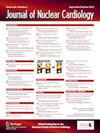Impact of transmurality and location on the diagnostic performance of 13N-ammonia positron emission tomography in the detection of myocardial fibrosis – A hybrid positron emission tomography/magnetic resonance study
IF 3
4区 医学
Q2 CARDIAC & CARDIOVASCULAR SYSTEMS
引用次数: 0
Abstract
Background
The influence of fibrosis transmurality and location on the diagnostic performance of positron emission tomography (PET) myocardial perfusion imaging (MPI) for detecting myocardial fibrosis remains unclear.
Methods and results
One hundred patients with suspected or known coronary artery disease (n = 50) or with a history of myocarditis (n = 50) underwent simultaneous cardiac magnetic resonance (CMR) and 13N-ammonia PET imaging on a hybrid positron emission tomography/magnetic resonance (PET/MR) device. CMR served as the reference with late gadolinium enhancement defining fibrosis of the left ventricular myocardium. PET MPI was assessed for fibrosis qualitatively (i.e. visually), semiquantitatively, and quantitatively (both threshold-based). From CMR, for every segment, the transmurality and location (subendocardial, midmyocardial, or subepicardial) of fibrosis were recorded. The sensitivity and specificity of qualitatively analyzed PET to detect fibrosis were 83.6% and 84.9% per patient and 52.9% and 96.4% per segment, respectively, outperforming the threshold-based semiquantitative and quantitative analyses. On a per-segment basis, the sensitivity of PET was increasing with transmurality and was dependent on location with higher sensitivities for subendocardial than subepicardial or midmyocardial fibrosis (P < .001). Overall median fibrosis extent, as depicted by PET, was significantly smaller than by CMR (2.0 [IQR 1.0-5.0] vs 3.0 [IQR 2.0-6.0] segments, P < .001).
Conclusions
PET yields high sensitivity for the detection of left ventricular (LV) myocardial fibrosis of ischemic or inflammatory etiology on a per-patient basis. However, compared to CMR, the overall fibrosis extent is significantly underestimated because, on a segmental level, sensitivities are significantly lower for fibrosis with lower transmurality and those located subepicardial and midmyocardial, as compared to subendocardial.

跨壁性和位置对13n -氨PET检测心肌纤维化诊断性能的影响——PET/MR混合研究
背景:纤维化的跨壁性和位置对正电子发射断层扫描(PET)心肌灌注成像(MPI)检测心肌纤维化诊断性能的影响尚不清楚。方法与结果:100例疑似或已知冠状动脉疾病患者(n=50)或有心肌炎病史的患者(n=50)在PET/MR混合装置上同时进行心脏磁共振(CMR)和13n -氨PET成像。CMR作为判断左室心肌纤维化的参考,晚期钆增强。PET MPI对纤维化进行定性(即目测)、半定量和定量(均基于阈值)评估。CMR记录每节段纤维化的跨壁性和位置(心内膜下、心肌中或心外膜下)。定性分析PET检测纤维化的敏感性和特异性分别为83.6%和84.9% /例,52.9%和96.4% /节段,优于基于阈值的半定量和定量分析。在每个节段的基础上,PET的敏感性随着跨壁性的增加而增加,并且依赖于位置,心内膜下比心外膜下或心肌中部纤维化的敏感性更高(结论:PET在每个患者的基础上对缺血性或炎症性左室心肌纤维化的检测具有较高的敏感性。然而,与CMR相比,总体纤维化程度明显被低估,因为在节段水平上,与心内膜下相比,对跨壁性较低的纤维化以及心外膜下和心肌中部的纤维化的敏感性明显较低。
本文章由计算机程序翻译,如有差异,请以英文原文为准。
求助全文
约1分钟内获得全文
求助全文
来源期刊
CiteScore
5.30
自引率
20.80%
发文量
249
审稿时长
4-8 weeks
期刊介绍:
Journal of Nuclear Cardiology is the only journal in the world devoted to this dynamic and growing subspecialty. Physicians and technologists value the Journal not only for its peer-reviewed articles, but also for its timely discussions about the current and future role of nuclear cardiology. Original articles address all aspects of nuclear cardiology, including interpretation, diagnosis, imaging equipment, and use of radiopharmaceuticals. As the official publication of the American Society of Nuclear Cardiology, the Journal also brings readers the latest information emerging from the Society''s task forces and publishes guidelines and position papers as they are adopted.

 求助内容:
求助内容: 应助结果提醒方式:
应助结果提醒方式:


